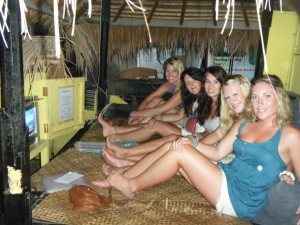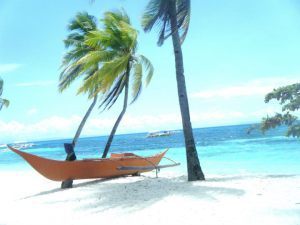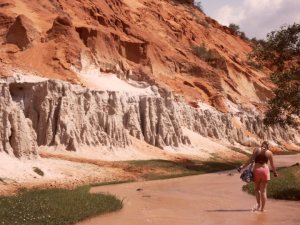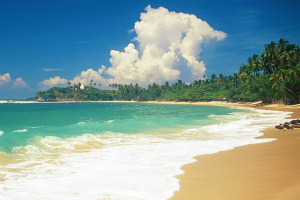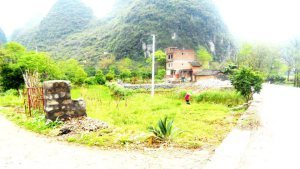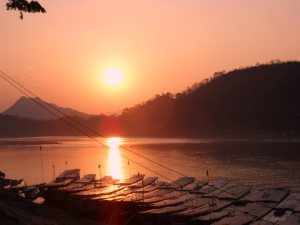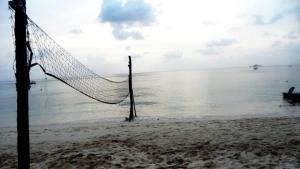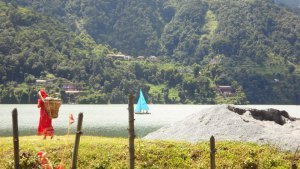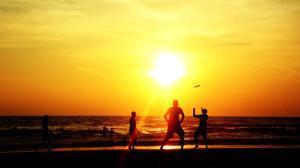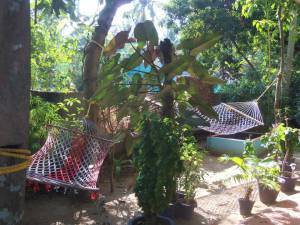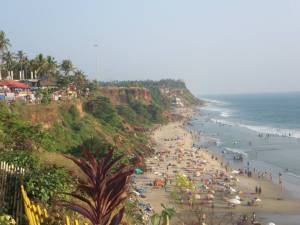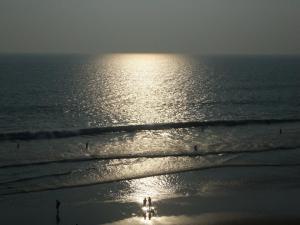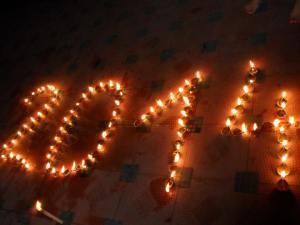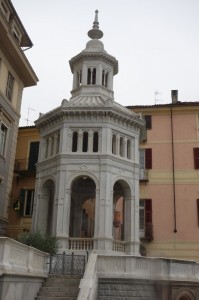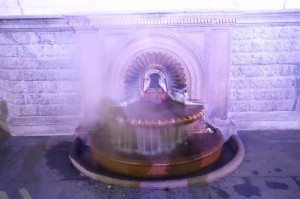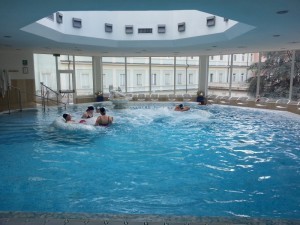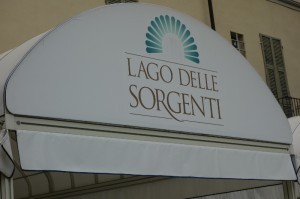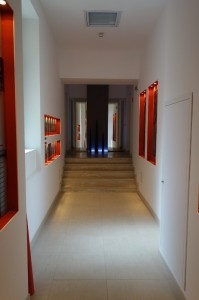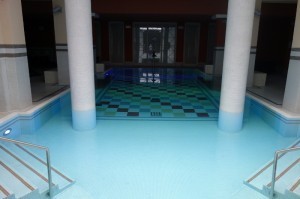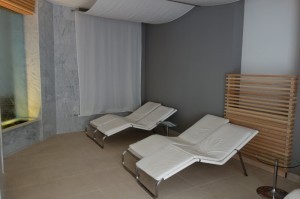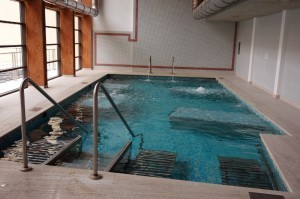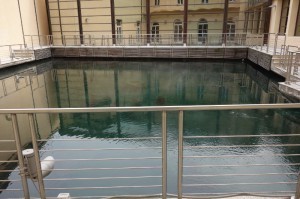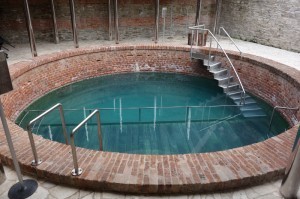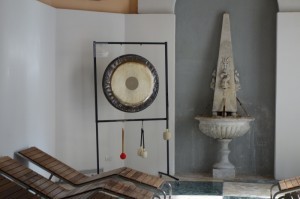Lisa Niver's Blog: We Said Go Travel, page 410
March 15, 2014
Delhi: Well of Solitude in India
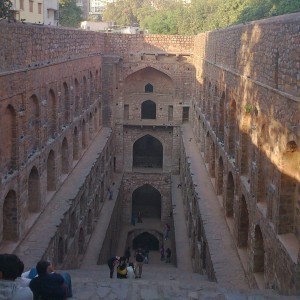 I never mused about a place that inspires me most until I landed on wesaidgotravel.com few days back and got apprised of the “Inspiration Travel Writing Contest”. I have been to many destinations, had fun, relishing memories, found peace and experienced all sorts of emotions one could expect but never looked them from the “inspiration” perspective. The contest made me shuffle through the memory lane to discover a place that stimulates me from the core. But before I pull off the veil, I would like to describe my perception of such place. I believe that such a place will absolutely not be an exotic and fancy tourist destination which I can imagine of being only on some hard earned vacation. On the contrary, I feel such a place would be somewhere in proximity and for which I do not have think and plan months in advance. Whenever I feel low, need motivation or simply want to spend time with myself, I can surrender myself in its arms without a second thought.
I never mused about a place that inspires me most until I landed on wesaidgotravel.com few days back and got apprised of the “Inspiration Travel Writing Contest”. I have been to many destinations, had fun, relishing memories, found peace and experienced all sorts of emotions one could expect but never looked them from the “inspiration” perspective. The contest made me shuffle through the memory lane to discover a place that stimulates me from the core. But before I pull off the veil, I would like to describe my perception of such place. I believe that such a place will absolutely not be an exotic and fancy tourist destination which I can imagine of being only on some hard earned vacation. On the contrary, I feel such a place would be somewhere in proximity and for which I do not have think and plan months in advance. Whenever I feel low, need motivation or simply want to spend time with myself, I can surrender myself in its arms without a second thought.
Now once “inspirational place” is defined, it’s time to pull off the veil from the “Well of Solitude”. It’s a place is located in the heart of Delhi amid the city’s busiest lanes yet offering serenity to its visitors. This inspiring destination is known as Agrasen Ki Baoli (“baoli” means step well) often referred to as “Well of Solitude” by few due to scanty number of visitors. It’s an ancient step well built in 14th century to save the populous from the scorching Indian summers. It’s a wisely carved out 60 m wide and 15 m deep piece of architecture with three levels and around 100 steps running deep down into its medieval soul. However, massive construction around the area has left it dehydrated but it still proffers solitude and solace to people like me. I came across it while hunting for some offbeat destinations during the initial days of my blog and found it to be a perfect retreat from the hustle-bustle of the capital city of India.
When I first entered the baoli, I was a traveller searching for unplumbed places to explore but when I left I was a lover, admirer, follower, addict and much more. I had seen several pictures before the first encounter but it appeared more riveting and ravishing in reality. It was the love at first sight akin to the romantic novels and I clearly knew in my heart that this is just a start to many more such frequent future encounters with the place. I was completely absorbed by its simplicity, elegance, architecture, stillness and quietude.
The step well does not expect much crowd as it’s identity has faded with depleting water levels; therefore, it appeared to be a coal mine of peace and tranquility to me. I sat on one of the steps gazing my newly discovered love and slowly thoughts pertaining to my nascent dream of being a traveler began to pour in. The quietude in the zone promoted some rationale thought process and aided me to focus and strive hard for my dream. The flapping sound made by the pigeons who has nestled themselves in small cavities of walls of the baoli added more charm and further enhanced the surrounding. I saw many squabs learning to fly in the precincts of the baoli, they fall, try, fall, again try, and the process continue until they finally master the art. It made me realize life does not come with candies, one has to struggle and make real, genuine and consistent efforts to soar high with their dreams. It made me introspect and question myself- Have I sweated enough to achieve and bring my dreams to reality? The question left me stumped as deep down, my heart whispered in negative. It was the day for self-realization and reckoning for me. Every human is aware of the universal truth that he/she has to battle hard to reach epitome of success, but, sometimes we require extra push which could come in any form. I discovered mine in the solitude of this ancient step well and squabs in its precincts’.
I spent around 3 hours at the baoli and really had no idea how time flew away. I was so engrossed in my thoughts that seconds turned into minutes and minutes turned into hours. Ever since my first encounter with the baoli, I am a regular and frequent visitor to my love. I often come here to celebrate “no responses” and sweet rejections from the editors whom I submit my travelogues for publication. It makes me realize that the efforts were not right enough to accomplish the goals which I have weaved for myself. Here I feel like a squab learning to master the art and the place motivates and encourages me to unfold my wings to try once more until I succeed.
About the Author- Kaushal Mathpal is a practicing lawyer in New Delhi, India but a wanderer at heart. An unfortunate accident last year rendered me immobile but gave me ample time to think and finally pursue my long desired dream of being a traveller, and sharing the same with others. I desire to take this as full time activity in future if possible.
Thank you for reading and commenting. Please enter our next Travel Writing competition and tell your story.
The post Delhi: Well of Solitude in India appeared first on We Said Go Travel.
March 14, 2014
USA: Time does not go; it travels
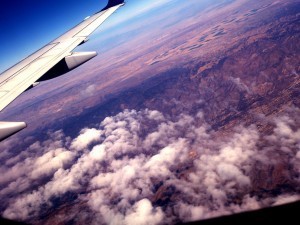 ‘Time yet for a hundred indecisions/ and for a hundred visions and revisions’ T.S. Elliot- ‘The love song of J. Alfred Prufrock’.
‘Time yet for a hundred indecisions/ and for a hundred visions and revisions’ T.S. Elliot- ‘The love song of J. Alfred Prufrock’.
There are a million places on this planet that can inspire people to live life to the fullest. Places that help us busy bees throw away our schedules for just a day, a minute, just a second even. Places that make us feel right in the middle of everything without trying to be. There’s Zuma beach, USA, where spending days watching the game between earth and ocean feels magical. The beach at Dingle bay, Ireland, feels like a safe haven when you are all alone save some seagulls and other sea life. Even the hustle and bustle of world cities such as Paris or Los Angeles can make us wonder, wander, and take us out of the daily grind. Yet, the forest just around the corner or the hotel chosen for a relaxing holiday can also help you unwind and provide you with inspiration. When given the chance to choose out of all the places I muster up in my mind, the most unlikely pops up: The road.
The road taken to travel to places on earth that we dreamed about: The road that leads us to the place where we explore and go beyond that feeling of indecision, insecurity, and fear that Elliot displays in his poem. I am talking about being on a train, a plane, a boat, a bus, or even a bike to a specific city or an unknown place.
Of course, you could say, time spent on the road is still living on a schedule. This is a good argument since trying to get from one place to the other means needing a form of transport that usually does not wait for you to be ready. But what I mean with time well spent on the road is the time you spend dreaming, making plans, revisiting plans, reading, chatting about dreams and plans, and making connections while going somewhere. Being ‘stuck’ on an 11 hour flight to Los Angeles might feel like time ticking away from you, but in reality it is time travelling, in both literal and figurative sense. Literally, obviously, because you are bound to pass some time zone while flying there (and may actually gain some time in the process) and figuratively because taking that flight means taking the time you are given to explore a different place with different customs. While on the road, time does not just pass but it ticks towards a goal, a place.
That I choose the road instead of a specific place is somewhat strange, since at least up to the age of 20 I hated travelling. I loved the part where you are safe and sound in your tent or hostel ready to do all the things you planned. I remember being on a bus to Killarney, Ireland, and dreading the whole event. Yet, when I think back on that ‘endless’ trip (I say endless because it was over 36 hours in total) I can only think of how much I saw, talked, and experienced.
My ardent hatred for travelling gradually turned into a love for being on the road, cycling for hours on end to finally arrive at your destination, being on a train that takes you from one country to the next in less than 4 hours, while you spend quality time reading, listening to music, chatting to random people, friends, or family. When travelling with others you have the chance to get to know each other better during the trip, learning things about someone you might have otherwise never known. Somehow, travel time forces you to take it slowly, unless, for instance, you miss your plane, your train is stuck in the middle of nowhere, or you lose your passport. But even those ‘slight’ mishaps can be the start of a realization penned up very wisely by Jason Wade of the band Lifehouse: ‘There’s no deadlines as long as you’re alive’ (Lifehouse- ‘Signs of life’). You can take that ‘lost’ time to do useful things such as talking to people, learning more about yourself, or just looking at the people at an airport and letting your imagination run free. You might get an idea for a book, a painting, or a letter you always wanted to write to someone. Being on the road is a flurry of butterflies in your heart that are looking for new horizons, new sunsets, fresh inspiration, and new experiences.
About the Author: Joyce Vos is an independent writer in the blogging, content writing, and translation field. Creative writing, travelling, and drawing/painting are also things she is passionate about. One of her many dreams is travelling as much as she can.
Thank you for reading and commenting. Please enter our next Travel Writing competition and tell your story.
The post USA: Time does not go; it travels appeared first on We Said Go Travel.
Hoori Haus, Nepal
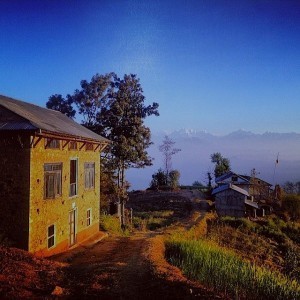 Stroll about Thamel, Kathmandu’s labyrinthine tourist quarter, and you’ll be surprised by the number of Chinese shoppers and hip Nepali partygoers. Where have all the hippies gone, you may well ask. You’re unlikely to find them in the urban crush of modern-day Kathmandu, the dusty vapours of which have all but obscured the Himalayan peaks that bound it to the north.
Stroll about Thamel, Kathmandu’s labyrinthine tourist quarter, and you’ll be surprised by the number of Chinese shoppers and hip Nepali partygoers. Where have all the hippies gone, you may well ask. You’re unlikely to find them in the urban crush of modern-day Kathmandu, the dusty vapours of which have all but obscured the Himalayan peaks that bound it to the north.
Yet some of them never left. Within an hour of settling into our newly leased house, set apart from a tiny, off-road hill village an hour east of Kathmandu, we were sipping masala tea with our American neighbours, who run the remarkable ‘Everything Organic’ farm. Jim and Judith, long-term residents of Nepal, were kind enough to let us run riot in their thriving nursery, and we gleefully gathered bunches of salad, arugula, spinach, chard and carrots for what we imagined would be our first meal.
We were wrong. As we cut through fields to our ridge above the farm and sat in the fading winter sun admiring the crystalline spread of the Himalayas, the schoolteacher who’d leased the house to us invited us to the village. And so we found ourselves munching on popcorn and soybeans roasted in a pot over a wood fire, sipping on rich buffalo milk as the first stars began to prick the violet sky.
It was dark by the time we said our goodbyes and lurched down the hill. Chilly and windy, too. But the thick mud-and-stone walls of our two-story house granted us a coziness quite lacking in the concrete high-rises of the city. We set about a meal of pasta and salad with gusto, sketched out a list of what we needed to furnish our newly dubbed ‘Hoori Haus’ (Windy House), then bedded down in our sleeping bags.
Early to bed, early to rise was never truer. By six I was eyeing the tangerine horizon over the black silhouette of the mountains through the window; by seven we were out in the sun again, savouring fresh Nepali coffee and greeting schoolkids as they tripped down to school in boisterous clusters.
The best thing about all this is that it can be every day for as long as we want: we’ve leased the house for the equivalent of fifty dollars a month. It may work as a handy hideaway far from the madding crowd for many of our friends, but for me, Hoori Haus is much more than a holiday home. I write for a living but Kathmandu, for all its scattered beauty, is too much of a social distraction and an infrastructural disaster for sustained work. There are many places to write about, but not to write in. Arnold Bennett may have said time is the one thing no one can take from you, but traffic jams were not a feature of 19th-century England. Up here, six thousand feet above sea level with the Himalayas a constant prospect, there is little to subtract the time that has been allotted to me. With no internet or television, my time will be spent doing what, of late, I find I have only been talking about doing: writing.
I will write about the things around me – the canary-yellow mustard fields, the dawn chorus of jungle birds and village roosters, the green hills, the clusters of villages dotting the valley below, and the 25000-foot mountains to the north. The long-eared goats, the cows, the smiling, whistling herders, too. I will write of the pure air and the good earth, and I will write of things that have happened and things that will never happen. And when my words falter, I will walk through the forests to clear my head and stop by at my neighbours, Nepali and American. I will tell them what I’ve been writing of, and I will ask them what they’ve been thinking of. And I will string these days together, one by one, until I’m ready to revisit the wider world and reveal to them what I’ve discovered. Not much will have changed there, I’m certain, but they may find that I have.
About the Author: Rabi Thapa is a writer and editor based in Kathmandu, Nepal. He is the author of ‘Nothing to Declare’ (2011), a collection of short stories.
The post Hoori Haus, Nepal appeared first on We Said Go Travel.
Tripping down Asia’s Memory Lane: My Top 10
I have never understood how anyone can like January. The sad, sinking feeling caused by limp, leftover tinsel hanging in shops, braving the dreary weather without any promise of a mulled wine stop, realising that everyone you know has vowed to lose weight, save money or quit drinking- it is a real slog of a 31 day month. For me, the January Blues are hitting particularly hard this year (can you tell?) Having spent Christmas on holiday in India, flying back to reality on New Years Day has left me longing for backpacking adventures again. So, before I get a grip, look forward and make plans for 2014, here are my top 10 beautiful places in Asia, home to my happiest past travel memories.
10. Tiger Leaping Gorge, China
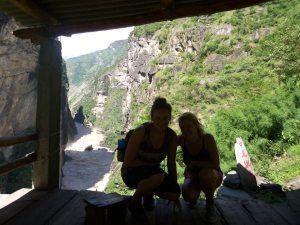
late July in Walnut Garden
By far and away the best thing I did whilst traveling around China, The Tiger Leaping Gorge hike in northern Yunnan is, in my opinion, still massively underrated. The Hutiao Xia gorge, at 16km long and 3900m from the Jinsha River to the snow capped Haba Shan, is simply breathtaking. During summer the hills are absolutely teeming with plant and flower life and an even pace allows you to unwind in the picturesque villages along the way. The trail stretches between sleepy Qiaotou and even sleepier Walnut Garden and runs high along the northern side of the impressive gorge, passing through some of the most diverse and beautiful landscapes in the country.
Jane’s Guesthouse in Qiaotou is the perfect place to prepare or recover from the trek. The food is homemade and hearty, the coffee is strong and the rooms are cosy with clear views of the snow-capped peaks. At the other end, Sean’s Spring Guesthouse is worth every footstep of the extra walk into Walnut Garden. Keep following the painted yellow arrows- you will not regret it! We finished our trek with warm Tibetan bread, celebratory beers and an open fire in Sean’s homey lounge.
The hike can be completed in a day or two, but it is equally tempting to linger and enjoy countryside life for longer. After all, how often do you get to watch the sun set over Jade Dragon Snow Mountain while supping Chinese tea and resting your tired feet?
9. Gili Islands, Indonesia
girls night in a bamboo hut
There is a lot to be said for an island with no motorized traffic. Being able to stroll around the parameters, barefoot and still sandy from the beach, having left your friends snoozing on one of the shoreline sofa beds, is reason enough to make the trip across the water from Padang bai. Though they are certainly not undiscovered, the three irresistible Gili islands offer a quiet and serenity that the rest of Bali simply does not.
Made up of beachfront bungalows, white sands and warm waters, Gili Trawangan is the isle with the most going on. Like many of the Indonesian hotspots, it ticks all the boxes for a desert island cliché and also boasts an exciting nightlife for those living-the-dream on the South east Asia trail. Designated party venues mean you can choose between a night at one of the low-key raves or whiling away the hours at a beachfront restaurant. Highlights for me were the Nutella milkshakes, having our very own DVD night in a private beach hut, dancing under the stars at Rudy’s Bar and night swimming with phosphorescence- luminous plankton.
You can reach the tiny tropical islands by fast boat from Bali and mainland Lombok or (painfully) slow ferry from Padang bai and Senggigi. Prepare to wade ashore.
8. Malapascua Island, The Philippines
beach at Logon
This little island off the northern tip of Cebu is sun-bleached and fabulous. Simple villages, bustling basketball courts and local fiestas play a huge part in making this tiny speck of The Philippines a traveler’s paradise. Though it is slowly becoming more and more popular, Malapascua remains off the beaten track and humble in its approach to tourism. Home to welcoming locals and some dive school expatriates, the island community is peaceful and charming with a real sense of having left the western world behind.
The diving here is also world class. With three wreck dives, a sea-snake breeding centre and daily thresher shark sightings, Malapascua is one of the best places in The Philippines for big fish encounters. Night diving is popular, with mandarin fish, seahorses, bobtail squid and blue ring octopus making regular appearances. And if marine life isn’t your thing, the delicious local food, mesmerizing sunsets and picture-perfect Bounty beach make for a blissful dry land experience.
Sunsplash Restaurant operates a beach bar during high season and is the perfect place to wait for the sunset. For the very best views and an extra slice of quietude, stay at Logon or Tepanee.
7. Mui Ne, Vietnam
Suoi Tien fairy spring
For someone with a notoriously terrible sense of direction, the surf capital of southern Vietnam offers a welcome sense of order. With everything spread out along one 10km stretch of highway, it is impossible to get lost and easy to find friends. In fact, with guesthouses lined up on one side of the road and restaurants and shops flanking the other it couldn’t be any easier to negotiate your way around the coastal town.
Once an isolated stretch of sand, Mui Ne is now famous for its unrivalled surfing opportunities and laid back vibes. For windsurfers, the gales blow best from late October to April while surf’s up from August to December. Luckily for me, lounging around on the beach is possible all year through. For the very best Kodak moments, the red and white sand dunes provide endless hours of sledding fun and jump-as-high-as-you-can competitions with the local children. A beautiful walk along the Fairy Spring will also take you past some stunning rock formations. While it feels as though you should be wading upstream barefoot, be sure to take shoes if you are going during the midday sun.
When night falls, resident DJs, beach bonfires and live bands draw the surfer crowds to DJ Station, Wax and Joe’s 24 hour Café, where happy hour can and usually does last til sunrise.
6. Unawatuna, Sri Lanka
turquoise tinted waters
Unawatuna Beach in Sri Lanka is what I hope heaven looks like. Deliciously lazy, exceedingly tropical and just so very, very beautiful, this sandy gem is the kind of place everyone dreams about. Life moves slowly here. Sleeping under a swaying coconut palm is about the only thing on the itinerary for most.
Following the devastating effects of the tsunami in 2004, locals of Unawatuna set about re-building their businesses right on the sand. While this does mean that the beach is much smaller than it used to be, honey-mooners and hippies alike flock to this boomerang shaped bend to soak up the Sri Lankan sunshine. And it really doesn’t get much better than this. The sea is gentle, turquoise and perfect for swimming and banana lassis are brought to your very sunbed. Colourful tropical fish swim in the live patch of coral in front of Submarine Diving School and you can rent snorkel masks from any of the places on the beach. I discovered a whole new meaning of lazy in Unawatuna but, if you want to leave utter beach paradise, it is a great base from which to explore the surrounding areas.
(This one does come with a warning. A cockroach warning. It is not enough to get Unawatuna booted off the list, but please note that multiple hard-shelled creepies do feature in my memories of this otherwise utterly perfect corner of the resplendent isle. Having said that, I did choose to stay somewhat off the beaten track at Mr.Rickshaw’s brother’s cousin’s place. It is very likely that the crayon-box cute guesthouses on the beach are roach free.)
5. Yangshuo, China
cycling through Aishanmen village
For the perfect blend of bustling Chinese culture, enchanted landscapes and sleepy relaxation, look no further than this sedate and peaceful ancient city. Worlds apart from the mayhem of congested Guilin, Yangshuo lies in the mist of karst limestone peaks and the gentle Li-river. Cycling through the villages will take you past duckmen, fishermen, water buffalo and clementine farms, as well as over silky brooks, ancient caves and sights like Moon Hill and the Big Banyan Tree. And when you’re done with the countryside, get lost amongst the painted fans and embroidered costumes of Yangshuo Town and its cheery market place.
I stayed at beautiful Dutch guesthouse, The Giggling Tree in Aishanmen Village. Bamboo rafting was on our doorstep and they arranged transport to the Lakeside lightshow, ‘Impression Sanjie Liu’. Cycling into town for street side specialties, souvenir shopping and live folk music was easy enough, although the starlit ride back after a few Tsing Tao’s was a little shaky!
4. Luang Prabang, Laos
Mekong River at sunset
You can’t help but smile when you are in Laos. The people here are possibly the most laid back people on earth. Even after two long, long days of doing nothing on the slow ferry, arriving into the languid mountain kingdom of Luang Prabang makes you want to s-l-o-w d-o-w-n. Tourists meander down the French colonial streets to the flow of the Mekong River and saffron robed monks seem to almost glide up and down the shaded sideways on their way to prayer.
Voted one of the best places in the world for ‘slow travel’ by Lonely Planet, this hushed and heady city offers everything from red roofed temples to quaint provincial coffee houses, the moonstone blue Kuang Sii waterfalls and exquisite night markets. You can watch the sun setting over the river, hear the monks chanting their oms in the distance and enjoy delicious local dishes with a cold Beer Lao. With a curfew bidding this heritage listed town goodnight at 11.30pm, catching up on your sleep has never been so enjoyable, especially if you are recovering from tubing in Vang Vieng. (For a much less sleepy evening, ask a tuk-tuk driver to take you to the local bowling alley. Trust me on this one.)
3. Mira Beach, Perhentian Pulau Kecil, Malaysia
beach on our doorstep
When I discovered that Beach Tomato had included Mira Beach as one of its ‘world’s most beautiful beaches’ I physically stood up and clapped. I almost don’t want to say it aloud for fear of contributing to this unspoilt patch of paradise becoming, well, spoiled, but I couldn’t agree more. Set back on the western side of tiny Kecil island, Mira Beach is its very own secluded cove. Surrounded by forest-green jungle, lapped by bathtub warm sea and drenched in Malaysian sunshine, the white bay can be reached by taxi-boat or Tarzan inspired trek only. Steer clear if you’re looking for plush resort or summer luxury though, the stilted chalets are as basic as they come. Managed by a local Malay family, the collection of rustic huts are kept clean and framed by frangipanis for ultimate postcard perfection. We left by water-taxi, tanned and having swum with turtles. Heaven.
2. Pokhara Valley, Nepal
Lakeside
Whether you are in Nepal for trekking the Himalayas, volunteering with an NGO or spotting the rhinos and elephants, a visit is not complete without catching a glimpse of (or a good long gaze at) Lake Phewa in Pokhara. Popular for being the gateway to the AnnaPurna trekking circuit, the valley has been blessed with panoramic views of this breathtaking region. Waking up to crystal clear views of snowy Mt. Fishtail, boating on Phewa’s placid waters and hiking to the sunkissed World Peace Pagoda could not have made me any happier. Throw in the cups of masala chai at Asian Teahouse, the surrounding Tibetan villages and the unimaginable hospitality of the local people and I was about ready to miss my return flight home.
Guesthouses are homely, food is hearty and the scenery really is spectacular. Pokhara is so much more than just a place to rest your feet after a hike. A month here saw us paragliding from Sarangkot, exploring the Old Bazaar, playing guitar in an underground Blues bar and falling in love with the children of the Himalayan Children’s Care Home. Don’t miss out on the Nepali specials at Asian TeaHouse and Pandey Restaurant. For me, the smaller the café, the better the food. Venture away from those Lakeside favourites!
((Drum Roll please…))
frisbee at dusk
If Varkala were a fairytale, it would be the one that made you believe in love, trust in the happy ending and doodle hearts and flowers in your notebook.
Nestled in the evergreen state of beautiful Kerala, this seaside town offers sunlit red ochre cliffs, coconut palm fringed beaches and peacock blue waves. The liquid lulls of local Malayalam, coconut spiced South Indian curries and breathtaking views of the ocean make it the perfect haven from the hustle and bustle of India’s cities. After ten days here, I wondered how I’d ever been happy anywhere else in the world.
From the singing mango-seller on the sand ‘yum, yum, yum, yum, eating eating’, to the cheeky waiters at the cafes, the locals on the cliff have got it exactly right. You could while away days, weeks and months watching the lives and loves of fishermen, frisbee-playing locals, moonlit yoga classes, Hindu temple men and strolling backpackers. Guesthouses are secret gardens and bamboo huts, restaurants are candle lit and family run and the Tibetan market wafts incense until after dark. Yet, far from being just a serene stopover, Varkala boats a ‘Shanti Shanti’ soul and cheeky community spirit that binds even the quietest visitor under its spell. By night, lanterns twinkle, candles flicker and stars burn bright over the backpacker favourites. I never knew beer could taste as good as it does here; poured from a discrete tea-pot, served with a glinting smile and supped to the blissful sounds of ocean, music and laughter.
If you tire of strolling, swimming, sunbathing or smoothie-drinking easily, the charming Varkala Town is just a 5 minute scooter ride or leisurely walk away. Surfing lessons, yoga classes and cooking workshops are all available atop the rosy cliff too. For dolphin watching, walk past the quieter Black Beach to the hamlet of Edava and watch from the cliff curve.
My heartfelt recommendations for Varkala are breakfast at The Juice Shack, hammock swinging at Secret Garden Homestay and Restaurant and cold Kingfishers at Backside Café. If you’re lucky enough to be there when the Alleppy Boys are playing, get down to Chill Out Lounge for a jamming session with the gorgeous and very talented local band.
There are daily trains and buses to Trivandrum, and a backwater boat to Alleppy leaves from neighboring Kollam.
hammocks at Secret Garden Homestay
Varkala Cliff
sea view from Juice Shack balcony
New Year’s Eve at Secret Garden
The post Tripping down Asia’s Memory Lane: My Top 10 appeared first on We Said Go Travel.
Traveling the World with My Son
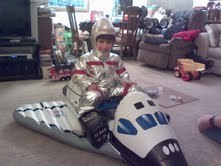 “The real voyage of discovery consists not in seeking new landscapes, but in having new eyes.” — Marcel Proust
“The real voyage of discovery consists not in seeking new landscapes, but in having new eyes.” — Marcel Proust
I’ve traveled to some spectacularly beautiful places in my lifetime. I’ve visited over a dozen countries in Europe, 21 US states and four Canadian provinces so far, and there’s still so much I haven’t seen yet.
I’ve camped and kayaked on Lake Huron in Canada and watched stunning sunsets over the lake. I’ve climbed to the roof of the Chartres Cathedral and explored the chateaux in the Loire Valley in France. I drank fresh coconut milk from a street vendor in Rio de Janeiro, Brazil and visited the Little Mermaid in Copenhagen, Denmark. I’ve been to Hollywood, California and Times Square, New York, and I spent a week living in a remote village in northern Alaska.
Of all the places I’ve traveled so far, though, the place that has most inspired me to spend my time wisely with no regrets has been…my son’s daycare center. I know it doesn’t sound like much of a vacation destination, and if you don’t have kids, I’m sure you wouldn’t choose to go there instead of to some more exotic locale, but I must say that I didn’t regret a single minute of the time I spent there, watching my son sleeping, seeing him roll over for the first time, taking his first steps and saying his first babbling words. I loved — and love — watching him explore his own small corner of the universe.
Seeing everything through his eyes changed the way I experience the world, and I wouldn’t trade a minute of that time for any of my other travel adventures.
If anything, watching him grow makes me want to bring him with me on my adventures and show him what an amazing planet he lives on. I want him to expand his sense of adventure beyond just camping near home, to see that the world is so much bigger than himself.
My son has been traveling from Los Angeles to Canada with me to visit his grandparents since he was a baby. He’s great on long flights, much to the relief of our fellow passengers.
When he was two years old, I took my son to Florida to watch a Space Shuttle launch. The family videos from that trip were so sweet, with my toddler saying, “I’m touching a moon rock.” He watches our home movies of that trip while wearing a silver astronaut costume and sitting on an inflatable space shuttle in our living room. My son “remembers” the trip from the videos we took that week, since he was too young to recall the details of the trip on his own.
When he was three years old, we spent ten days in Tokyo in the spring, when the cherry blossoms were in bloom. We experienced Tokyo by visiting parks, zoos, and playgrounds in addition to temples, shrines, and palaces. Traveling was different with a little kid in tow. I needed to keep in mind what would interest him, and how far he could travel in a day before naptime. I even had to determine which subway stops were stroller-accessible.
Exploring even more of the world with my son will open his eyes — and mine — to new experiences, new cultures, new friends, and new vistas. I want to take my son to see the Grand Canyon someday. I want to show him animals in their native habitats, not just in zoos. I want to see the world through his eyes as well as my own. Our adventures together are only just beginning…
About the Author: Rachel Zimmerman Brachman: By day, I work as a solar system education specialist. In my free time, I write manuscripts for children’s books. I’m an inventor, a scientist, an educator, a writer, a mom, a knitter, and a world traveler.
Thank you for reading and commenting. Please enter our next Travel Writing competition and tell your story.
The post Traveling the World with My Son appeared first on We Said Go Travel.
March 13, 2014
Malin Head, Ireland
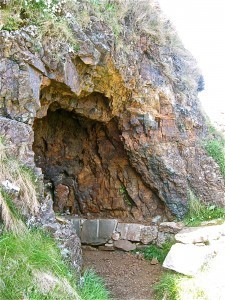 Sitting in The Harp in Sligo, my husband and I consult a map. We want to go to the farthest-north point on the Irish Atlantic coast: Malin Head. “Next stop, Greenland,” says an old gentleman who overhears our choice. We down our pints and head for the car. Arriving in Malin Head, we book into the Sea View Tavern and are greeted personally by Michael, the owner. This place has been in his family a long time and has three bedrooms upstairs above the pub. The three large windows in our spotless room face onto the North Atlantic, with a view to the lighthouse on Inishtrahull. Michael has a large wind turbine on the property; it stands in the same field where the sheep graze.
Sitting in The Harp in Sligo, my husband and I consult a map. We want to go to the farthest-north point on the Irish Atlantic coast: Malin Head. “Next stop, Greenland,” says an old gentleman who overhears our choice. We down our pints and head for the car. Arriving in Malin Head, we book into the Sea View Tavern and are greeted personally by Michael, the owner. This place has been in his family a long time and has three bedrooms upstairs above the pub. The three large windows in our spotless room face onto the North Atlantic, with a view to the lighthouse on Inishtrahull. Michael has a large wind turbine on the property; it stands in the same field where the sheep graze.
Malin Head has that end-of-the-earth feeling. Our first day here, we drive the short distance to Banba’s Crown, high point of the headland, where we see WWII bunkers and also the remains of an ugly high concrete tower built by the Brits. Climbing the north-facing rocks, we watch the North Atlantic chopping at the shore with white-edged knife blades. On the grass far below, remains of chalk spell ‘EIRE’, marks left by a neutral people in that time of bombs. On this wind strewn cliff still stands a concrete spotter’s hut. On the soot-blackened walls, traces remain of those who watched, huddled by night around a feeble fire.
Coming back down, we have a pint in Farren’s, the hangout of the locals. A story comes on TV (even the most ancient-looking Irish pubs have modern flat screen TVs) about Donald Trump building the world’s largest golf course in Scotland. Some adjacent property owners object, calling Trump “arrogant and ignorant.” This starts quite the debate in Farren’s. The barman says the new golf course will bring in jobs and raise property values.
A rumpled old character who reminds me of Eamon in Ballykissangel says, “Not in my back yard; them bicyclists will bother my sheep.”
A white-haired gentleman previously quiet chimes in. “Ye shouldna have your sheep in the public road!”
Eamon says, “The motorcyclists!”
The barman says to the patrons at large, “He just doesn’t like people.”
Says Eamon, “I like my own company very much.” We try to keep straight faces.
Next day, we walk to the Wee House of Malin, a natural cave in the stony hillside. It is said a holy hermit lived here for many years; even today people make pilgrimages here in August. Visitors have stuffed hundreds of coins into cracks in the rock walls. Outside the cave stands a glassed-in Blessed Virgin statue, originally in the school on Inishtrahull, but moved to Malin Head when the island was abandoned. She looks out to sea, and there are offerings at her feet: candles, flowers, seashells.
In the afternoon, we drive a few kilometers to the Five Fingers Strand, a Blue Flag beach. I sketch the far shore with the dark hills rising. The five fingers are reddish rock clumps projecting below the far right bluff. Returning from Five Fingers, we see a sign outside the Crossroads Inn advertising a table quiz that evening, to raise funds for the Sea Rovers Football Club. The pub is walking distance from our lodgings at the Seaview; we cannot resist.
There are lots of questions on Irish sports, Irish TV shows, Irish politicians. They play ten rounds of ten questions each. At the question “name the Great Lakes in North America,” the team at the next table looks over at us quickly writing the answer and asks, “Want some sweets?” They are a terrific bunch, the young footballers and their girlfriends. We win a bottle of wine for the Proverbs Round, in which a bunch of first letters are listed and we figure out the saying. Example: AAADKTDA = an apple a day keeps the doctor away. The prize for best team name: the group next to us, who are also the funniest, and come in first overall. They call themselves E = MC Hammer.
Sign on the back bar at Crossroads Inn: “Please do not ask for credit, as refusal so often offends.”
Writing-wise, this location is nourishing. I have seven new poems written, and yesterday decided on the working title for the book that will come from this trip. Michael is enthusiastic about offering copies of my future book for sale here. After four days at Malin Head, we are in love with the place, but our room has been booked by members of a large walking group, and the rest of Ireland beckons.
About the Author: Sheryl Clough is a poet, photographer and editor living on Whidbey Island in Washington State. Her book “Ring of Fire, Sea of Stone” won the 2013 San Gabriel Valley Literary Festival Chapbook Prize.
Thank you for reading and commenting. Please enter our next Travel Writing competition and tell your story.
The post Malin Head, Ireland appeared first on We Said Go Travel.
Feeling of Family in Tajikistan
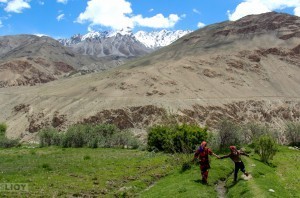 Nikita and Maria are clearly sisters, though they never explicitly say so. Aside from their common resemblance, the way the run together hand in hand along a small stream goes a long way towards describing their relationship with one another. As they lead us towards an old Silk Road fortress that predates Marco Polo’s visit to the region by several hundred years, the girls stop to pick out a tasty root (they insist we try it after eating a bit themselves to make their point) or point out an old inscription now nearly covered by plant growth.
Nikita and Maria are clearly sisters, though they never explicitly say so. Aside from their common resemblance, the way the run together hand in hand along a small stream goes a long way towards describing their relationship with one another. As they lead us towards an old Silk Road fortress that predates Marco Polo’s visit to the region by several hundred years, the girls stop to pick out a tasty root (they insist we try it after eating a bit themselves to make their point) or point out an old inscription now nearly covered by plant growth.
To friends from home, the very notion of a trip to this region is unwise. Straddling the border between Tajikistan and Afghanistan, the international market in the main village of Ishkashim will in fact be the site of an assassination only a few weeks after we pass through the area. During our visit, however, the only regret we’ll feel is perhaps not trying hard enough to connect with our hosts one evening or not trying enough varieties of the Iranian candy that comes across from the Afghan market. That’s the strange thing about regret in wisdom, though: they only make sense in retrospect. In the moment, as we travel and live, we can only try to make the decisions that seem most appropriate at the time.
Relaxing around a dimly lit sitting room in their small house, Maria and Nikita’s entire family is full of laughter and questions. Their father, with whom I share enough language to have a basic conversation, asks about out map and our travels and why we came to the village of Ratm far into Tajikistan’s Wakhan Corridor. The surface reason, and the one I answer his questions with, is of course this “First Fortress” that for so long has guarded the Wakhan from invaders out of China. These days the only “invaders” into the Wakhan seem to be the occasional tourists, visiting the area as a loop off of the Pamir Highway or en route to go trekking in a remote corner of Afghanistan.
Only after we leave Nikita and Maria’s house will I realize that the moment that sticks most strongly isn’t of the fortress itself, but of these two girls who so happily walk us there. Without any consideration for themselves, they simply drag along two foreigners – after all, we could only reasonably be there for one thing! In so many regions of the world this would raise ‘travelers alarms’ immediately. “What are they going to ask for? Pens and candy? Money directly?” With these two, however, the concern just isn’t there. We sit on top of an ancient fortress, yet laughing with them is the clear focus of the moment.
Their whole family atmosphere feels this way. The youngest sister of five walks around making faces at each in turn while the father sits beside me and pours over the map of Tajikistan. They offer tea and bread, as would be expected to guests in any Wakhani home. Consummately Japanese, my girlfriend responds with impromptu origami while all I have to offer is photos view from the display of a camera. It is not much, but somehow it is more than enough. We bond as strongly with this small family as we have with hosts and friends with whom we share a complex discussion (or at least a commonly language!), in part because Maria and Nikita’s love for each other and for their family is a gentle reminder that sometimes these simplest things are the most important.
Traveling through the Wakhan is full of moments like these, trading earrings with a feisty grandma at a bus stop and consulting with an Afghan physician about the right herbal remedy for blistered feet. Towards the end of the journey, at a homestay closer to Ishkashim, it turns out that our host family is related to our friends back in Ratm. We get an address, and mail photos from the next major town. Around the same time, a result of the assassination in Ishkahim, fighting breaks out in the regional capital and government services are suspended in the conflict. Ratm, and indeed most of the Wakhan Corridor, are remote enough that our friendly family should be fine. Traveling to the region? Perhaps it wasn’t as safe or wise as we’d believed. Having met only the friendliest families in the area, though, we look back at the trip without regret.
—–
About the Author: Stephen Lioy is a writer and photographer based primarily in Central Asia. Follow along on his travel blog as he explores the ancient Silk Road and beyond.
Thank you for reading and commenting. Please enter our next Travel Writing competition and tell your story.
The post Feeling of Family in Tajikistan appeared first on We Said Go Travel.
Relaxation In The Thermal Waters of Acqui Terme, Italy
While Acqui Terme is in the heart of Piemont, Italy, surrounded by some of the most famous vineyards, Acqui Terme is also known for its hot sulpher springs. After all, the name “Acqui Terme” means “Thermal Waters.” The hot sulpher springs, which bubble up at 167°F, date back to the Roman town Aquae Statiellae. You can head into the center of town where the little pavilion known as La Bollente (“the boiling source”), designed by Giovanni Ceruti in 1870, is a central attraction to locals and visitors alike.
The natural thermal waters rise up from underground in two places in Acqui Terme – The Bollente, which feeds the spa at the Grand Hotel, and on the other side of the Bormida River at the Lago delle Sorgenti (Lake of Hot Springs).
We began our trip at the Grand Hotel Nuove Terme. Built in 1891, the hotel includes a 1,000 square meter spa with a thermal swimming pool (96.8°) with a waterfall and hydro-massagers, two saunas, a Turkish bath, a solarium and seven beauty and massage rooms. We made this our home base and after a long flight, the best way to begin the trip was to take a dip in the hotel’s Roman Baths.
After three days of eating and drinking, we traveled across the to the other side of the river (only a few minutes from the center of Acqui Terme) to spend the afternoon at the Lago Delle Sorgenti Spa. Opened October 2010, this spa is more modern and new-age, compared to the older Grand Hotel. Set aside a few hours to spend here as the best treat is the 12-step “path” to relaxation.
Step 1: Start down the path of Anti-Stress
2: Enjoy the warm waters (95° F) of the Roman Pool. Float, swim, sit…whatever you want to do, you will start to reflect and relax. The Roman Pool includes ”waterfall” whirlpool jets and is the perfect setting for the “Himalayan Floating Sounds”, a ritual created specifically for the Spa, which is executed with the Tibetan Bells in alternation with the Water Qi-Gong.
3. Stop by the Falls Lake Lounge to rest.
4. The Moving Water Pool has massage jets and you should spend a few minutes at each jet. This pool is so peaceful and relaxing as the light comes in through the glass walls and as you look out at the Lake of the Springs.
5. After the Moving Water Pool, spend a few minutes outside around the Lake of the Springs and inhale the rising smoke .
6. Head to the garden-terrace where there are two large whirlpools with thermal water at 95° F.
7. Spend a quiet moment on the sun-terrace in the garden area around the wellness bar Taste & Nature .
8. Spend 5-15 minutes in the Finnish Sauna, a “dry” sauna where you will be surrounded by the aroma of essential oils: lavender, rosemary, mint, or exclusive blend used for treatments.
9. Shower with warm water and then with cold water before entering the Volcano of sources.
10. Relax again in the garden-terrace.
11. Enter the Steam Bath, which is rich in beneficial geothermal properties. A therapist will enter the room to perform the ritual of ”Environmental Harmony,” playing Tibetan bells and creating hypnotic music that soothes the body and mind.
12. End the journey in the Gong Lounge where a therapist performs the Planet Gong . The musical vibrations of the instrument is calibrated to the orbital frequency of the planet Pluto and induces a process of purification and holistic re-harmonization .
If you follow this path, you will feel reinvigorated and rejuvenated and ready to go explore the wines and food and Acqui Terme.
The post Relaxation In The Thermal Waters of Acqui Terme, Italy appeared first on We Said Go Travel.
Not Your Father’s Shop Class: Learning to be a Maker at the Exploratory
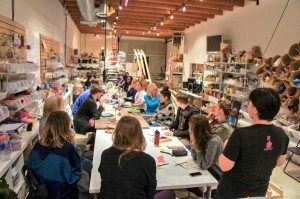 Jean Kaneko is a tinkerer. Being around her and the Exploratory, no adult or child can help himself or herself, you feel swept up in the ability to gather parts from open containers and start to make. Perhaps you are drawn to scraps of fabric to design your own plushie animal or you prefer to create your own video game with marshmallow controllers. Jean has joined together pieces to design, build, create and be a maker. She also draws together Lawrence Hall of Science, AmeriCorp, VistaCorp, USC BioMedical Engineers, social scientists, parents, teachers from all levels and all types of schools as easily as she assembled over 200 small wooden pieces to build a nerdy derby from an open space design at MIT or make a MakerBot Replicator 2 3D printer print a “statue” of a board member from over 20 iPhone photos from 123D Catch.
Jean Kaneko is a tinkerer. Being around her and the Exploratory, no adult or child can help himself or herself, you feel swept up in the ability to gather parts from open containers and start to make. Perhaps you are drawn to scraps of fabric to design your own plushie animal or you prefer to create your own video game with marshmallow controllers. Jean has joined together pieces to design, build, create and be a maker. She also draws together Lawrence Hall of Science, AmeriCorp, VistaCorp, USC BioMedical Engineers, social scientists, parents, teachers from all levels and all types of schools as easily as she assembled over 200 small wooden pieces to build a nerdy derby from an open space design at MIT or make a MakerBot Replicator 2 3D printer print a “statue” of a board member from over 20 iPhone photos from 123D Catch.
Many people in American question, “What is wrong with education?” If you are ready to be part of the solution, drive to Culver City and come learn with Jean and her incredible team. The Los Angeles Times recently reported that the SAT will no longer penalize for guessing, obscure words will be removed and the essay will be optional. It is true that testing and authentic assessment in schools is a problem. It is an issue that teachers have been discussing for years at our Los Angeles Science Teacher Network Meetings. What rubric do you use to fairly measure students of different aptitudes? If students can be nine types of smart from Howard Gardner’s Frames of Mind, how do we measure them?
How are You SMART? Many ways to be Intelligent! from Lisa Niver Rajna
Students are asking if school is worth going to? What will they learn? Will they be truly engaged? Will there be jobs for them at the end? Parents are worried if students are learning the right things. Michael Milken recently spoke to a sold out crowd of Wharton graduates about Global Prosperity in the 21st Century. What will make a difference to our future and our economy? “Education.” He said: “Lifelong learning and engaged citizens who care about themselves and our planet.”
How do we inspire lifelong learning and creative problem solving? With making. Last Wednesday night at the Milken Institute, Milken remarked that in the future on the International Space Station instead of bringing every spare part required they will use a 3D printer. On Thursday night at the Exploratory, I saw my first 3D printer and its results. It is a combination of art, science, sweat, tears and love to make all of these components work. Students and teachers are dedicated to understanding how to use rhino, maya, google sketchup, tinkerCAD and the other flavor of the month software programs to understand design and the many programs necessary in the steps to 3D printing. Being educated is a moving goalpost as the tools keep changing.
If we want to support entrepreneurship in schools and what we really want as parents, as partners, as members of a democratic republic, is engaged citizens who can evaluate new tools and choose wisely which politician to lead us or which software to learn, buy and work with we must teach creative thinking and problem solving.
Sir Kenneth Robinson said in his book, The Element:
“Children starting school this year (2009) will be retiring in 2070. No one has any idea what the world will look like in ten years’ time, let alone in 2070. There are two major drivers of change–technology and demography. Technology is developing at a rate that most people cannot properly grasp….the world population has doubled in the past thirty years, from three to six billion. It may be heading for nine billion by the middle of the century. This great new mass of humanity will be using technologies that have yet to be invented in ways we cannot imagine and in jobs that don’t yet exist.”
Many parents complained to me when I was teaching their children about time. Students feel overwhelmed by their schedules during the day, afterschool, homework. They want to be in sports programs, maker clubs, orchestra, robotics, foreign language classes, student government. Adults feel overwhelmed by messages from email, text, Facebook friends, social media pressures, job stresses, and of course in Los Angeles by traffic. How do we find the time to go to the Maker events and discover what we can build?
The question is what are we working toward? Do we want a child with a 4.5GPA with a perfect SAT score and an admission to a top school or something else? Can we have it all at the same time? One thing we can all learn at Maker is to make our own opportunities.
Choose to get involved by being a mentor or take a class at the Exploratory, find yourself with Ann Bradney at Radical Aliveness this Saturday or watch a video of Awesome Sylvia, or Joey with his marshmallow air cannon. There are many ways to participate in changing education and ourselves. Commit to taking a step this week, have a conversation about what is the goal of education, or learn about the new “Tree of Possibilities” and five ways to power a hand-made boat. The Exploratory has a $35 drop in fee. Stop by and meet one the amazing fellows for “office hours.” Visit with a monthly membership for $75 for one parent and child. I wonder what you will decide to Make!
About the writer: Lisa Niver Rajna has been traveling and teaching since 1990. Find her at We Said Go Travel or Science Isn’t Scary.
The post Not Your Father’s Shop Class: Learning to be a Maker at the Exploratory appeared first on We Said Go Travel.
The Road to Making a Difference in the Philippines
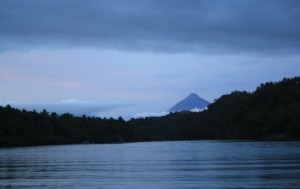 Sitting by the beach watching the sun turn from white to orange to red as it gets immersed in the sea is a moment that can switch on your creative button. It is a great spot to read a book, write a story, or simply sip a cocktail drink and breathe in the fresh sea air. These are simple joys that have become a luxury to a city dweller. Truly, the slow-paced life and simple living of a small locality will make you stop and smell the roses.
Sitting by the beach watching the sun turn from white to orange to red as it gets immersed in the sea is a moment that can switch on your creative button. It is a great spot to read a book, write a story, or simply sip a cocktail drink and breathe in the fresh sea air. These are simple joys that have become a luxury to a city dweller. Truly, the slow-paced life and simple living of a small locality will make you stop and smell the roses.
This is the quiet town of Donsol in Sorsogon, located at the southern tip of the Bicol peninsula in the Philippines. But aside from its relaxing atmosphere that is devoid of skyscrapers and traffic jams, Donsol is also the perfect place to commune with nature. Not only will you get to know more about the other living creatures in our planet, but you will also learn how to care for them.
Donsol is known as the town that is being frequented by whale sharks. This giant sea animal has been hunted down by man and sold in the market. Through the years, their population has been on a decline and their species is going into extinction.
It is inspiring to note that the men who used to poach these whale sharks, or butandings, as called in the local dialect, are now the ones who safeguard these animals. They trained with the local government and environment groups on how they can guide visitors in interacting safely with the butandings. Donsol is now a model community on how they engaged the enemies of the environment to become its friends and protectors.
Interacting with the whale sharks is a thrilling experience. The anticipation at early morning adds to the excitement. Roaming the sea, the spotter will point towards the direction of the whale sharks. Once it is in close proximity, the boats turn off their motors so as not to disturb the butanding. Then the call to “jump!” signals everyone to plunge into the sea. What happens next is breathtaking. A few meters below, one will see a huge figure that is only discernible through the white spots on its back. It is larger than life yet its bulky body swims gracefully beneath the sea, unmindful of the spectators at the surface. Swimmers are strongly instructed against going close to the whale sharks, gentle they may be, to avoid getting anyone hurt, including the giant animal.
Apart from the interaction with the butandings and a short seminar about their species and how to care for them, Donsol also offers a beautiful experience of romancing with the fireflies. At the setting of the sun, visitors head to the river for a boat ride. As darkness envelopes the town, sparkling fireflies that take shelter in trees along the riverbanks create a feeling of mystic delight. It is like having a Christmas tree with twinkling lights, only that these lights come from a natural source. Their humming brings a natural song to a quiet evening in the river that is surrounded by nipa plants.
Such experiences in Donsol bring a fuzzy feeling that is magical and astounding. As night settles in, the town falls in a deep sleep. And you will leave Donsol carrying its advocacy of preserving and protecting our ecology.
About the Author: Claire Marie Algarme lives in the 7,107-island nation of the Philippines, she loves to travel around her country and visit neighboring countries.
Thank you for reading and commenting. Please enter our next Travel Writing competition and tell your story.
The post The Road to Making a Difference in the Philippines appeared first on We Said Go Travel.
We Said Go Travel
We Said Go Travel is a global community of over sixteen hundred writers with articles from every continent.
Stories are shared with photos and video from a perspective of the transformative power of travel. We Said Go Travel has hosted live and online events as well as travel writing contests around the world. ...more
- Lisa Niver's profile
- 57 followers


